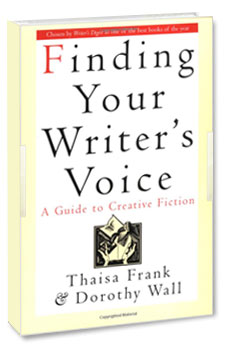Finding Your Writer's Voice
Thaisa Frank writes of lives that brush up against one another, but cannot fuse because of their characters' reluctance to be known, reluctance to be loved. A BRIEF HISTORY OF CAMOUFLAGE traces loss of love, elided empathy, and persistent memory in the cycles of knowing and not knowing one another. "My mother fell asleep right away and an ineffable membrane opened between us. I felt her heart and breath, fueled by mysterious powers, love beyond her knowledge of it." (from "Night Visit").
Praise
Does everyone in America want to be a writer? Publishers seem to think so, witness the never-ending flow from the presses of books on writing. (If publishers really do have their fingers on the pulse of America, buy stock in computer discs and spiral-bound notebooks.) Interestingly, most of these books, like Frank and Wall's, emphasize the creative aspect, not the mundane business end, of writing. Frank and Wall do, however, take a refreshingly novel approach to the subject of encouraging the beginning creative writer. Focus on voice, they suggest, for it will be what distinguishes you from the pack (of other writers buying such books as this). Happily, Frank and Wall practice what they preach in their own well-wrought book, whose voice is frank and objective but warmly conversational. The many exercises are intriguing and imaginative.
—Pat Monaghan
Voice is the thing that makes one writer's work different from another's. Every writer has a voice and a personal way of telling a story that reflects his or her life experience, sense of humor, and way of seeing the world. This book will help writers find their own voice-helping them move from raw outpourings to polished prose. The authors, writing professors at San Francisco State University and the University of California at Berkeley Extension, respectively, have included some exercises to help writers tap into their personal voice. For stories to be good, argue the authors, that voice must be true, powerful, and raw. The authors have focused on a writing skill that is very hard to teach, and they have done so successfully. The ideas they present are good, and the exercises should help writers get at the heart of their feelings and passions. Still, this book is useful only for libraries that serve a large population of writers.
—Lisa J. Cochenet, Winfield P.L., Ill.

